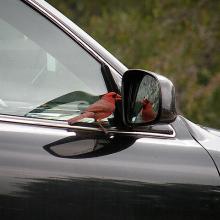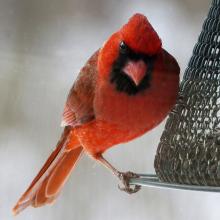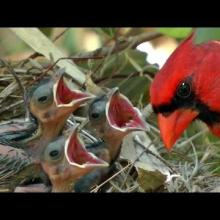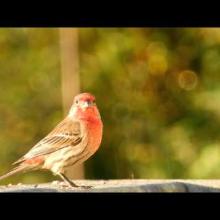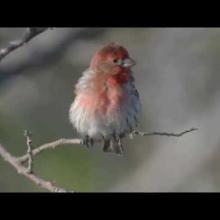

Join BirdNote tomorrow, November 30th!
Illustrator David Sibley and actor H. Jon Benjamin will face off in the bird illustration battle of the century during BirdNote's Year-end Celebration and Auction!
Male Northern Cardinals, Scarlet Tanagers, and House Finches all have striking red plumage that’s thought to play a role in attracting mates. Males with the brightest red feathering tend to have the best luck with the females. Scientists think that a male’s redness signals to females that he has just what it takes to help produce superior offspring. But just because a male is a brilliant shade of red... does that mean he’s stronger or more fit than his duller-colored competitors? It might be so, but it’s complicated…
BirdNote®
What’s Behind Those Lustrous Red Feathers?
Written by Bob Sundstrom
This is BirdNote.
[Northern Cardinal song, https://macaulaylibrary.org/asset/49062#_ga=2.23830841.2089825070.15498…, 0.05-.09]
Male Northern Cardinals, Scarlet Tanagers, and House Finches all have striking red plumage that’s thought to play a role in attracting mates. To develop red feathers, they need to eat seeds or fruit containing pigment molecules called yellow carotenoids. Their bodies then change those pigments from yellow to red.
Males with the brightest red feathering tend to have the best luck with the females. Scientists think that a male’s redness signals to females that he has just what it takes to help produce superior offspring.
[Northern Cardinal song, https://macaulaylibrary.org/asset/49062#_ga=2.23830841.2089825070.15498…, 0.05-.09]
But just because a male is a brilliant shade of red, does that mean he’s stronger or more fit than his duller-colored competitors?
Scientists think one answer may lie in a male’s mitochondria, the energy powerhouses inside the body’s cells. Research indicates that red carotenoids are concentrated in the mitochondria. And bright coloring is linked to mitochondrial performance.
In general, birds with the brightest color also tend to have better immunity, winter survival, foraging ability, and skill at avoiding predators.
[Northern Cardinal song, https://macaulaylibrary.org/asset/49062#_ga=2.23830841.2089825070.15498…, 0.05-.09]
So those bright red males may not be all feathers and no substance after all.
For BirdNote, I’m Michael Stein.
###
Producer: John Kessler
Executive Producer: Sallie Bodie
Editor: Ashley Ahearn
Associate Producer: Ellen Blackstone
Producer: Mark Bramhill
Bird sounds provided by The Macaulay Library of Natural Sounds at the Cornell Lab of Ornithology, Ithaca, New York. Northern Cardinal, ML49062, recorded by Gregory Budney
BirdNote’s theme was composed and played by Nancy Rumbel and John Kessler.
© 2020 BirdNote June 2020 / August 2023
Narrator: Michael Stein
ID# plumage-06-2020-6-23 plumage-06
[key study] https://www.biorxiv.org/content/biorxiv/early/2019/08/08/728873.full.pdf
https://royalsocietypublishing.org/doi/10.1098/rspb.2019.1354
[great background on carotenoids; predates above study] https://www.nature.com/articles/s41467-017-02649-z
carotenoids is pronounced kuh-RAHT-un-oidz




